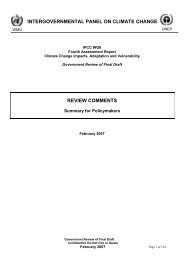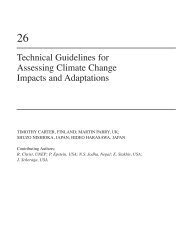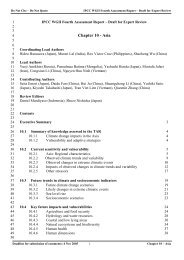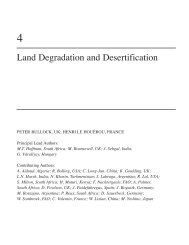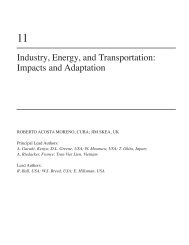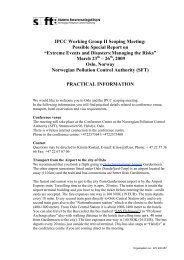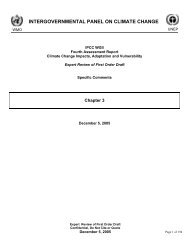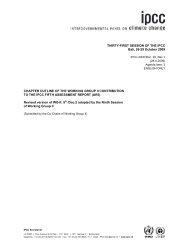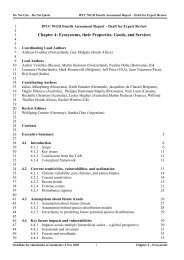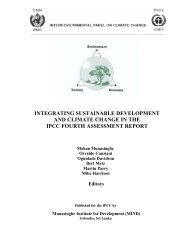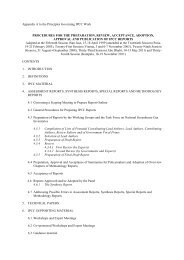IPCC Expert Meeting on Geoengineering
IPCC Expert Meeting on Geoengineering
IPCC Expert Meeting on Geoengineering
You also want an ePaper? Increase the reach of your titles
YUMPU automatically turns print PDFs into web optimized ePapers that Google loves.
Summary of the Synthesis Report<br />
<br />
<br />
<br />
<br />
<br />
The risks and impacts of geoengineering techniques might be best assessed within the c<strong>on</strong>text of the risks and impacts<br />
of climate change and other resp<strong>on</strong>ses to climate change such as mitigati<strong>on</strong> and adaptati<strong>on</strong>, rather than in isolati<strong>on</strong>.<br />
CDR and SRM methods might be assessed with a comm<strong>on</strong> framework of criteria; for a holistic (i.e., inclusive of all<br />
potentially relevant aspects) comparis<strong>on</strong> of resp<strong>on</strong>se opti<strong>on</strong>s, it could be valuable if the framework were also applied<br />
simultaneously to mitigati<strong>on</strong> and adaptati<strong>on</strong> resp<strong>on</strong>ses. The following list of criteria is proposed for c<strong>on</strong>siderati<strong>on</strong> by<br />
AR5 authors but is likely not to be comprehensive and would need to be carefully evaluated as part of the assessment<br />
process:<br />
<br />
<br />
<br />
<br />
<br />
<br />
<br />
<br />
<br />
<br />
<br />
Effectiveness – could assess how effective the technique would be at achieving its specified goal (i.e., in<br />
removing CO 2 out of the atmosphere for CDR methods, or changing the radiative budget and/or reducing<br />
specific climate change impacts for SRM methods);<br />
Feasibility – could assess the state of technological/engineering readiness for deployment of the<br />
technique (at a small scale; i.e., separate from assessing the physical or social challenges of expanding it<br />
to large-scale deployment);<br />
Scalability – could combine assessments of both physical (i.e., climatic, envir<strong>on</strong>mental, resource-related)<br />
and social (i.e., ec<strong>on</strong>omic, political) limits <strong>on</strong> how much and how fast deployment of the technique could<br />
be scaled up to achieve a specified goal;<br />
Sustainability – could combine assessments of the reversibility of impacts and assumed l<strong>on</strong>ger-term<br />
commitments associated with deployment of the technique, evaluated against baseline scenarios for<br />
climate change and diverse socioec<strong>on</strong>omic pathways. Links to the precauti<strong>on</strong>ary principle could be<br />
c<strong>on</strong>sidered;<br />
Envir<strong>on</strong>mental risks – could identify and assess the physical, chemical, biological and climatic risks<br />
associated with the technique (including, but not limited to, residual climate change impacts, unintended<br />
c<strong>on</strong>sequences, risks inherent in the irreversibility or terminati<strong>on</strong> issues assessed in the sustainability<br />
criteria);<br />
Costs and affordability – could combine assessments of (a) the costs of implementing and operating the<br />
technique (direct costs) with (b) the cost valuati<strong>on</strong>s for potential social and envir<strong>on</strong>mental externalities<br />
generated by the technique or its failure (indirect costs). Costs would need to be evaluated against a set<br />
of baseline mitigated and unmitigated climate scenarios;<br />
Detecti<strong>on</strong> and attributi<strong>on</strong> – could assess the extent to which both targeted and unintended c<strong>on</strong>sequences<br />
of the technique could be detected and attributed to its deployment (i.e., verificati<strong>on</strong> of CO 2 withdrawal<br />
for CDR, or identificati<strong>on</strong> of climatic impacts for SRM);<br />
Governance challenges – could assess the legal and regulatory issues (local, nati<strong>on</strong>al and internati<strong>on</strong>al)<br />
that are or could be associated with the technique, al<strong>on</strong>g with an assessment of whether/how current<br />
instituti<strong>on</strong>s address these issues;<br />
Ethical issues – could identify the variety of ethical issues that are or could be raised by the technique;<br />
Social acceptability – could assess current knowledge of the social acceptability of the technique;<br />
Uncertainty related to all of the above menti<strong>on</strong>ed criteria.<br />
In order to ensure c<strong>on</strong>sistency in the treatment of geoengineering in the AR5 using a comm<strong>on</strong> framework, an informal<br />
group of AR5 Lead Authors from all three working groups might be formed. This might help to arrive at a ‘holistic’<br />
assessment of geoengineering in the AR5.<br />
Once sufficient knowledge and published literature <strong>on</strong> SRM and CDR methods become available, the <str<strong>on</strong>g>IPCC</str<strong>on</strong>g> might want<br />
to c<strong>on</strong>sider a joint Special Report <strong>on</strong> Ge<strong>on</strong>engineering post AR5.<br />
As the deployment of some geoengineering technologies could have profound l<strong>on</strong>g-term implicati<strong>on</strong>s for global<br />
society, assessment of the proposed methods will need to c<strong>on</strong>sider timescales extending at least up to, and likely well<br />
bey<strong>on</strong>d, 2100.<br />
<str<strong>on</strong>g>IPCC</str<strong>on</strong>g> <str<strong>on</strong>g>Expert</str<strong>on</strong>g> <str<strong>on</strong>g>Meeting</str<strong>on</strong>g> <strong>on</strong> <strong>Geoengineering</strong> - 4



